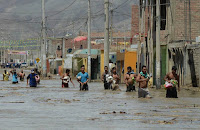An unusual coastal El Niño drove Peru's deluge, in another signal that weather extremes are becoming wild cards as climate change warms the oceans.
Peru's worst floods in nearly a century have killed more than 70 people, left 70,000 homeless in nearly every province and damaged 130,000 structures, including ancient archaeological sites. The downpours inundated the country in the first half of March, then moved north over Colombia, causing a mudslide that killed hundreds.
The intense rain and flooding in Peru took emergency workers and scientists by surprise, because such extreme downpours typically are associated with a large-scale El Niño phenomenon. But the latest El Niño ended nearly a year ago.
The flooding instead has been linked to an exceptional and sudden emergence of extra-warm ocean waters just off Peru's coast, what scientists call a coastal El Niño. Since mid-March, NOAA satellites have showed this patch of the eastern Pacific as the most anomalously warm ocean region in the world.
It won't be clear whether human-caused global warming was a direct factor in the flooding unless scientists do an attribution study. That would determine how much the buildup of heat-trapping greenhouse gases increased the odds of it happening. But the unusual heat blast and flooding are consistent with global warming, according to scientists.
"There's been a big increase in really heavy rainfalls around the world. Storms are moving more slowly, carrying more moisture. That's the new normal," Jim White, said director of the Institute of Arctic and Alpine Research at the University of Colorado, Boulder. "At 400 ppm of CO2 in the atmosphere, pretty much everything should be carrying a signature of climate change, it would be odd if it didn't. The question is not so much is this event caused by climate change. The question is, which event is not?"
Since the 1950s, the world's oceans have absorbed more than 90 percent of the extra heat trapped in the Earth's atmosphere as a result of the increase in greenhouse gas emissions.
"The eastern equatorial Pacific has warmed by about 0.5 to 1 degree Celsius since 1950, which is likely a result of anthropogenic climate change," said Mojib Latif, a climate scientist at the GEOMAR-Helmholtz Center for Ocean Research in Kiel, Germany.
"This could be sufficient to boost the impacts of a coastal El Niño."
South America is not alone in experiencing coastal ocean heatwaves. Other recent examples include the notorious warm blob that persisted off the coast of the Pacific Northwest from 2013-15 that spawned a toxic algae bloom and shut fisheries. Persistently warm ocean temperatures off the eastern U.S. coast and in the Caribbean likely intensified tropical storms like Matthew and Irene, according to climate scientists, and record ocean warmth in the Gulf of Mexico helped fuel the devastating downpours and floods last August in Louisiana.
Read more at Peru's Floods Follow Climate Change's Deadly Extreme Weather Trend

No comments:
Post a Comment